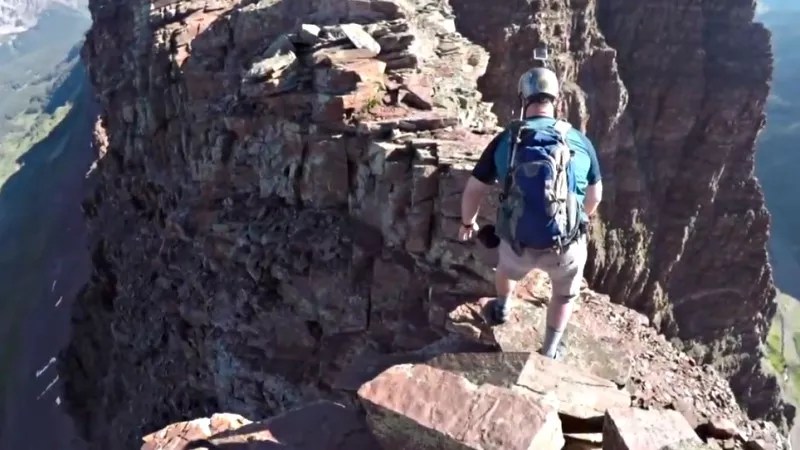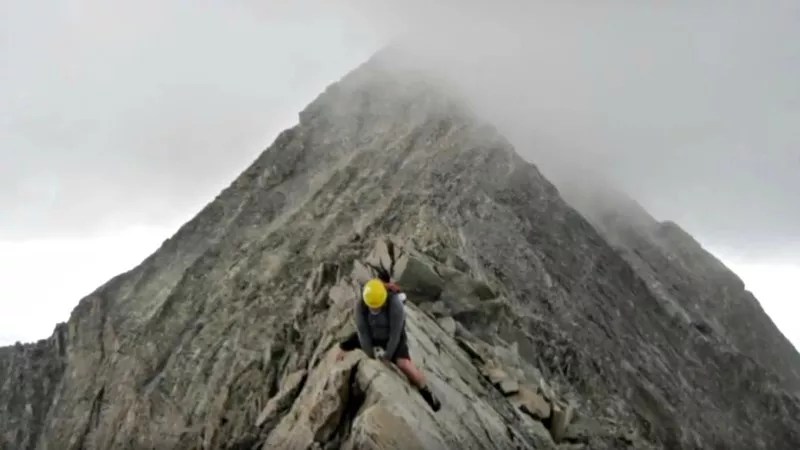

Audio By Carbonatix
Today, July 19, the Colorado 14ers Initiative is scheduled to release the latest video in a new series about best practices and safety when climbing the Colorado peaks that exceed 14,000 feet. The collection includes a roundup of the state’s most dangerous fourteeners: the six mountains where the highest number of deaths have occurred so far this century. But Initiative executive director Lloyd Athearn acknowledges that the roundup isn’t the final word on the subject, in part because of a tragedy that took place after the video was completed.
Kit Carson Peak and Challenger Point, a pair of fourteeners in the Sangre de Cristo range that are so close in proximity they’re often tackled in a single climb, weren’t highlighted in the video despite as many as three fatalities on the former since 2010 and a 2017 fall from the latter that resulted in the death of Dr. Jamie Rupp. But then, on June 27, Challenger Point claimed another victim: Tyler Cline, whose goal was to climb all of Colorado’s fourteeners – 54 by Athearn’s count, though that’s a matter of debate among members of the mountaineering community.
Less than two weeks later, on July 10, James Hasse, 61, died on South Maroon Peak, one of the Maroon Bells, located in the Elk Mountains. By sheer coincidence, the Initiative had planned to release a video about the Elk Mountains two days later, on July 12. But when staffers learned about what happened to Hasse, they moved the schedule up a day. As Athearn recalls, “We were like, okay, this is when people are going to be paying the most attention.”
The education doesn’t stop there – because the risks don’t. In addition to Kit Carson Peak, Challenger Point and the mountains cited in the video, Althearn believes that relative climbing novices should steer clear of another five to ten Colorado fourteeners unless accompanied by a professional guide or someone with a lot more experience. (See that roster below.)
The Initiative’s growing number of videos- there are now more than sixty – represent an evolution of its mission. “Some people might ask, ‘Why are you guys involved in safety when you’re principally about building trails and restoring alpine vegetation?'” Athearn concedes. “But rescue groups will tell you that if there’s an injured person and they’re going out to save them, they might be sending thirty to fifty people – and if they’re looking for someone who’s lost, they’re going to be trampling in the alpine on these fragile plants.”
For that reason, he continues, “the more we can get people to be safe and be clear-eyed in choosing objectives, the better.”
Athearn offers the following example (one that resonates given a recent fatality in Boulder County): “People need to know before they start climbing that there are going to be thunderstorms almost every afternoon. So if you don’t have proper rain gear and you’re petrified of lightning dancing right next to you and you start running straight down the hill, you’re probably doing a lot more damage than if you’d planned ahead and went early in the morning and were off the peak by noon.”
Here’s how Athearn describes the mountains that made the cut in the video, which he narrates.
“Number one is Longs Peak,” he points out. “I don’t know if it’s because Longs is visible from Denver and it’s one of the most dramatic of the fourteeners, or if it’s because Longs Peak has so many different routes other than the standard route. But numerically, it’s had more fatalities than any other fourteener since 2000.”
Also included are three peaks in the Elk Mountains: the aforementioned Maroon Bells, plus Capitol Peak and Snowmass Mountain. These attractions share plenty of attributes.
“Those mountains are all steep and they have notoriously bad, loose rock on them,” Athearn stresses. “Most of the time when people get into trouble on them, they’ve gotten off route, ended up in loose terrain and fallen. In our video about the Elks, we have some experienced locals who have been or currently are guides say, ‘Look, I’ve climbed this mountain numerous times and I’ve never done exactly the same route.’ It’s easy to get off route, and the minute you do, the more free-and-clear, loose rock you’re likely to see. You can find yourself on a downward slope with all sorts of loose rock that one mountain rescue expert described as like being in a room of poker chips, where everything is sliding around under your feet. All of the Elks are that way.”
(Other Elk fourteeners: Castle Peak, Conundrum Peak and Pyramid Peak.)
Crestone Needle and Little Bear Peak, also named in the video, are both in the Sangre de Cristo range where Kit Carson Peak and Challenger Point are located. “They have slightly better rock, but very steep terrain, Athearn notes. “If you fall, you’re likely to fall a few hundred feet. And that’s not going to go well.”
The Initiative lists the mountains by the number of deaths that occurred on them between 2000 and 2017:
Longs Peak: 19
Maroon Bells: 12
Capitol Peak: 9
Crestone Needle: 6
Snowmass Mountain: 5
Little Bear Peak: 3
Peaks are rated using a five-tier system. As described by the Initiative, Class 1 peaks boast “easy hiking, usually on a good trail.” Class 2 peaks sport “more difficult hiking that may be off-trail. You may also have to put your hands down occasionally to keep your balance…. Class 2 includes a wide range of hiking and a route may have exposure, loose rock, steep scree, etc.” Class 3 peaks require “scrambling or un-roped climbing. You must use your hands most of the time to hold the terrain or find your route. This may be caused by a combination of steepness and extreme terrain (large rocks or steep snow).” Class 4 peaks are straight-up climbing: “Handholds and footholds are required for upward or downward progress. Rope is sometimes used on Class 4 routes, because falls can be fatal. The terrain is often steep and dangerous.” And those who tackle Class 5 peaks must engage in “technical climbing. The climbing involves the use of rope and belaying.”
The peaks in the video are all ranked as Class 4; none of the Colorado fourteeners are considered in the Class 5 category. But as Athearn sees it, considerable expertise is required to safely tackle even the Class 3 peaks.

Another image from the video “Mountain Safety: The Deadliest Colorado 14ers.”
“You have forty or so fourteeners that have well-developed trails and they’re moderate peaks. You might have a little off-trail scrambling,” he concedes. “But it’s really the last ten to fifteen, when you get into third-class terrain or higher, where you’re not so much following a well-developed trail as you’re on your feet and occasionally using your hands, and you’re having to navigate more. All of a sudden, you need a different skill set.”
Among the videos in the planning stages is one Athearn references as “‘Introduction to Third Class,’ where we will talk about some of the peaks that would be good for you to make the transition from hiking on a trail you can follow and move more into off-trail conditions where you have to be more mindful of what’s going on around you on the mountains and how to navigate.”
Colorado fourteeners that offer Class 3 climbs include Wetterhorn Peak, Wilson Peak, Mt. Eolus and El Diente Peak, as well as Longs Peak’s Keyhole Route, where Jens “Jay” Yambert died last year – sad proof that mountains with lower-difficulty ratings can still prove treacherous.
This last fact was reinforced by two events yesterday, July 18. First, the body of 71-year-old Englewood resident Don Chambliss was found on Torreys Peak, a Class 2 fourteener; the cause of death for Chambliss has not yet been determined, but Athearn stresses that fatal medical episodes such as heart attacks can happen even on more modest climbs. Meanwhile, former astronaut Jeffrey Ashby was rescued from La Plata Peak, another Class 2, after a fall estimated at 500 feet caused injuries described as severe.
The suggestion that climbers with limited expertise hire a guide before attempting to scale Class 3 or Class 4 peaks, as explored in a video released on July 15, has generated some negative feedback, Athearn notes: “Some people are like, ‘I don’t have $500 or $700 to pay out for a guide service.’ But if you have to be transported by an ambulance or by Flight for Life or something like that, you’re talking about a lot more than that – maybe even tens of thousands of dollars. It’s sometimes odd the false economies that people engage in. They won’t think twice about hopping on a plane to fly out here to rent a hotel room and then climb a peak, but they don’t want to spend a few hundred dollars to make sure they’re safe. And they’re still climbing the mountain. It’s not like someone is going to put them on a rope and winch and pull them up.”
In Europe, hiring a mountain guide is commonplace, but not so in the U.S. – and he’s not sure why. “Before I spent a decade at the Colorado 14ers Initiative, I spent a decade as the deputy director of the American Alpine Club, where I got to understand a lot about climbing psychology.” Athearne says. “And there is something to the individual mentality of climbing that people can be stubborn. They can be like, ‘I want to do this on my own. I want to sort this problem out myself.'”
True, he continues, “climbing is an opportunity to test yourself in nature and see where your boundaries are – to see what you can do and strive to do bigger and bolder things than you’ve ever done before. But I think we’ve seen over the past few years that sometimes people don’t have a good calibration of where their abilities are relative to the objectives they’re taking on. So for those people who say, ‘I really want to climb all the fourteeners’ to check off their bucket list, we want to encourage them to think about taking a mountaineering course or hiring someone to guide them up the more difficult peaks. It seems like a reasonable thing to consider.”
The video scheduled for release later today will focus on Capitol Peak. To see it and all of the Colorado 14ers Initiative clips, visit the organization’s YouTube channel.